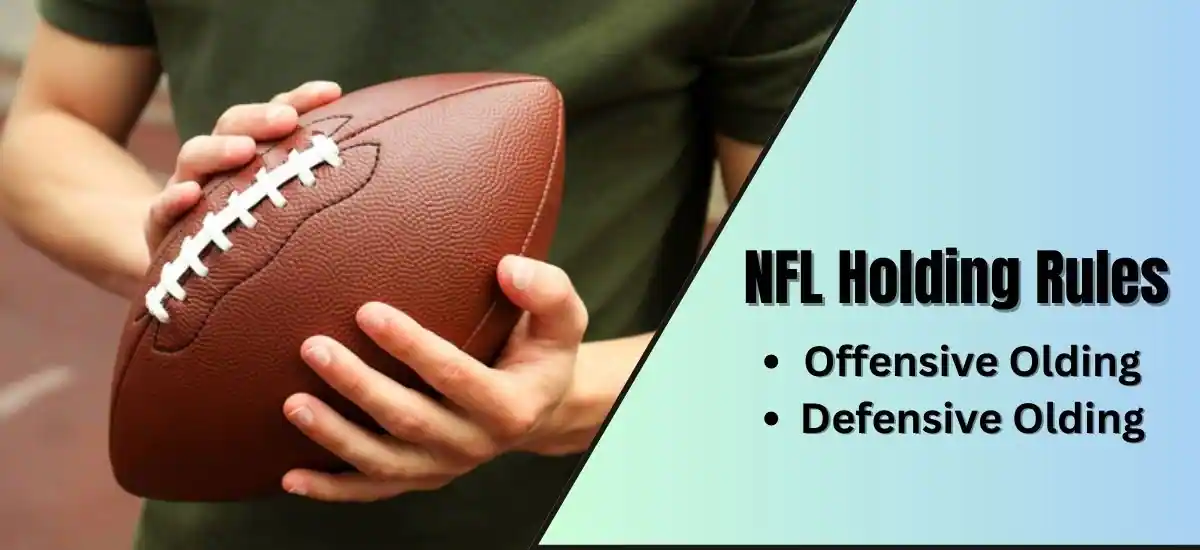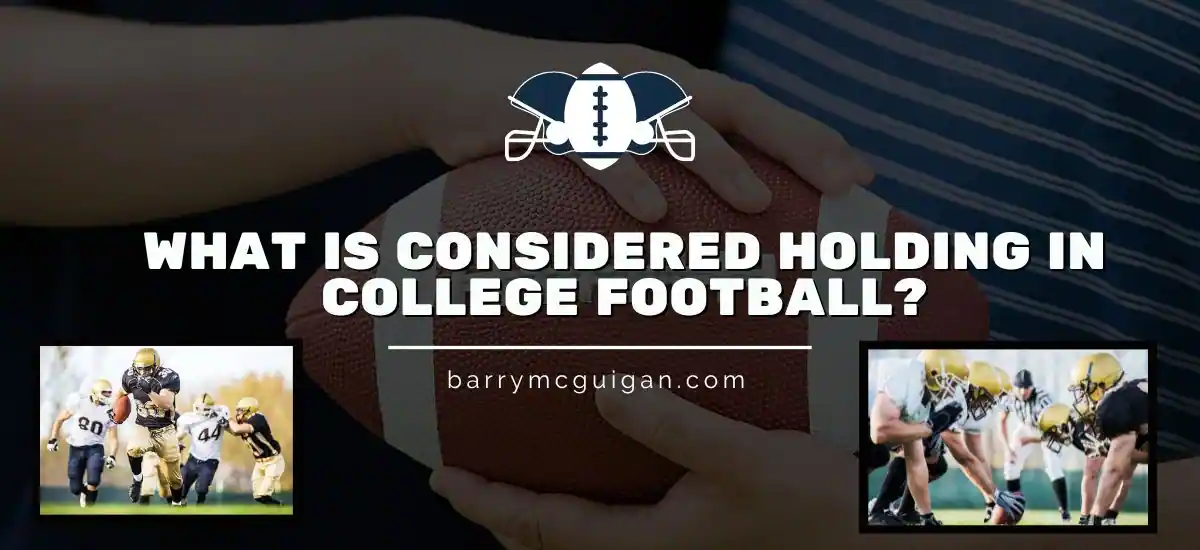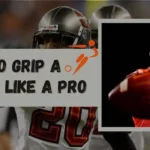What Is Holding In Football? Using one’s hand or arm to illegally detain another player in gridiron football when that player does not have control of the ball is called holding. Most football leagues have decided to ban holding since it disrupts the game flow, increases the likelihood that someone will be hurt, and decreases player safety.
When there are less than 20 yards between the line of scrimmage and the offense’s end zone, a holding penalty loses 10 yards or half the distance to the goal line. Holding penalties within the attacking end zone result in safety for the defense. It’s a typical American football penalty.
Holding is the most common penalty in football. Thus fans should be familiar with it. In this article, we’ve defined what is holding in football, differentiated offensive from defensive holding, and discussed other difficulties. Continue reading to learn more.
What Does Holding Mean In Football?

An unlawful off-the-ball foul is called holding while trying to block an opponent. When a team is called for holding, they get a penalty that may cost them five or ten yards from the line of scrimmage. If it’s determined that the offense was offensive holding, the penalty is 10 yards. On the other hand, a defensive holding penalty results in a loss of five yards and an immediate first down.
Offensive And Defensive Holding
Defensive: When a player on defense holds the ball for an extended period, this is considered the same as holding the ball offensively. Any 11 players on the defensive team can make this mistake. When a defensive player interferes with an offensive player who is not carrying the ball, the defensive player is guilty of defensive holding. Defensive holding happens more often when cornerbacks and wide receivers go up against one another in one-on-one battles.
Offensive: The offensive holding found in the NFL Video Rulebook states that it occurs when a player “uses his hands or arms to significantly impede an opponent or modify the defender’s course or angle of pursuit.” It does not matter if the blocker’s hands are within or outside the frame of the defender’s body; the offense is still considered a foul.
To be considered holding, an action must meet all three criteria:
- Grasping or tackling an opponent
- Hooking or twisting an opponent
- Dragging an opponent to the ground
Is it a violation to retain a spot? In football, a holding penalty may be called a spot foul in certain situations, but in others, the penalty will be assessed from the line of scrimmage. A holding penalty is converted into a personal foul when a play continues beyond the line of scrimmage.
Examples Of Holding In Football
If the holding happens while the score is tied at two and three, then play is immediately halted. The down is restarted for the offense after it backs up 10 yards from where it was initially standing on the field. The next play, therefore, will be second down and thirteen yards.
The offender is only subject to the entire penalty distance if they are located at least 20 yards from their end zone at the time of the infraction. If the offense is inside their 20-yard line, the penalty yardage will be equal to half the distance to their own goal line instead of the standard penalty yardage.
On the other hand, the defense can refuse the call, which may or may not be exercised depending on the circumstances. The defense can avoid taking the penalty if, for instance, the violation happens on third down during an incomplete pass. However, it instead results in the throw being incomplete, which leads to a fourth down and compels the offense to kick the ball.
NFL Holding Rules

Offensive Olding
Make use of his hands and arms to physically limit an opponent or change the trajectory or angle of the pursuit of a defense. It does not matter whether the blocker’s hands are within or outside the frame of the defender’s body; the action is still considered a foul. The following are examples of material constraints. However, the list is not exhaustive:
- seizing or taking down an adversary;
- hooking, pulling, twisting, or rotating him; or
- dragging him down to the floor with you.
Defensive Olding
It is a foul for defensive holding if any of the following apply:
A defensive player may tackle or hold any opponent who is not a runner, except in certain situations allowed explicitly in Article 5. During a punt, field goal attempt, or Try-kick attempt, B1 grabs and pulls an offensive player out of the way, allowing B2 to shoot the gap (also known as “pull-and-shoot”) to block the kick. The exception is if B1 is advancing toward the kicker, in which case B1 does not perform this maneuver.
Note: Any offensive player who pretends to possess the ball or one to whom a teammate pretends to give the ball can be tackled until he crosses the line of scrimmage between the tackles of a regular tight offensive line. This rule applies even if the offensive player actually possesses the ball. The penalty for defensive holding is a loss of five yards and a first down on the next play.
What Is The Penalty For Holding?
When the offensive team is punished for offensive holding, they are forced to take a 10-yard step back from the line of scrimmage. For instance, if it is first and ten from the offensive team’s 25-yard line, the penalty for holding would change the situation so that it is first and 20 from the offensive team’s 15-yard line.
If the offensive team receives a holding penalty within their 20-yard line, the ball will be pushed back to the point where the holding penalty occurred. The defensive team receives a penalty for holding, which results in the offensive team receiving five more yards and an automatic first down.
For illustration’s sake, let’s say the play is a 2nd and six from the offensive side’s 30-yard line, and the defensive team commits a holding penalty. As a result, the offensive side would get the ball at their 35-yard line with a first-and-10 situation.
Suppose the defensive team commits holding when the offensive team has possession of the ball within the defensive team’s 20-yard line. In that case, the ball will be pushed forward 50 yards, and the defensive team will receive a penalty equal to the ball’s distance traveled.
What Is The Signal For Holding?
Holding one wrist firmly in one hand while clenching the other in front of the chest makes unauthorized use of one’s hands, arms, or body. Holding one wrist in one hand, the other hand open in front of the chest and looking forward.
What Is Considered Holding In College Football?

An unlawful off-the-ball foul is called holding while trying to block an opponent. When a team is called for holding, they get a penalty that may cost them five or ten yards from the line of scrimmage. If it’s determined that the offense was offensive holding, the penalty is 10 yards. On the other hand, a defensive holding penalty results in a loss of five yards and an immediate first down.
In addition, inside 20 yards of the end zone, a holding penalty reduces the distance to the goal by 50 yards. Is it considered holding if you grab a jersey? No player may hold the runner’s inner collar, side shoulder pads, or jersey at the nameplate or higher. It doesn’t apply to a runner or quarterback in the tackle box.
Pros And Cons Of Holding
Pros
- The penalty that may occur on almost every offensive play, including field goals, attempts at extra points, punts, and kickoffs, is known as the dead ball.
- It implies that the offense will earn an additional 10 yards if the referee decides to call a penalty on them, and it will also cancel out whatever happened on that play, resulting in a new down being played.
- When a defensive player commits to holding in the National Football League, the team receives a penalty of five yards and an automatic first down.
Cons
- It also makes it impossible to play the game fairly and raises the possibility of being hurt.
- The first time someone watches a game, it might be challenging to understand what constitutes holding and what does not, as well as to discriminate between the two.
- The fact that referees may call it on attacking players, as well as defensive ones, can make things rather complicated.
Frequently Asked Question
Q1. Is grabbing shoulder pads holding?
Ans: Nope, if you grasp a player’s shoulder pads while blocking, you will be penalized for holding, just as you would be if you grabbed his jersey. But, again, it is because the shoulder pads are part of the player’s equipment.
Q2. What’s the difference between pass interference and holding?
Ans: Interfering with a pass is something that happens while the ball is in the air, whereas holding is something that happens before a throw. Therefore, if a defender maintains physical contact with a receiver while the ball is in flight, the defender will be penalized for pass interference rather than holding.
Q3. Can you hold a receiver within 5 yards?
Ans: A defensive player can throw an eligible receiver in front of him anywhere inside the region that extends five yards beyond the line of scrimmage. While the receiver is within the 5-yard zone, the defender may make continuous, unbroken contact as long as the receiver is even with the defender.
This rule applies only if the receiver has not moved further than a position where they are even with the defender. Additionally, this rule only applies if the receiver has not advanced beyond a position where they are even with the defender.
Q4. Can you slap in football?
Ans: You indeed may, but if you accidentally slap a player’s hand on the other side while doing it, you’ll be called for a foul. Snatching is another option, which is a fierce technique to use if feasible.
Related Post:

